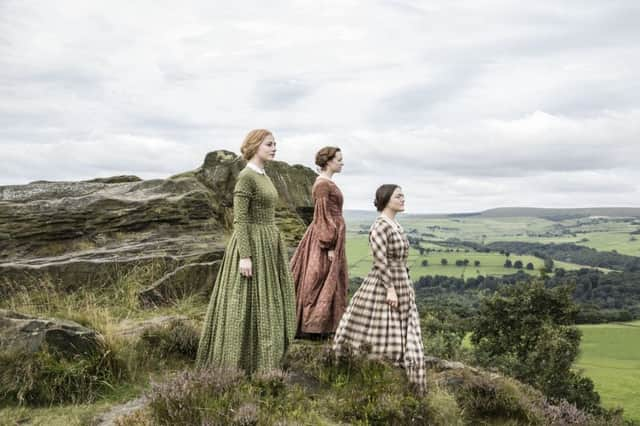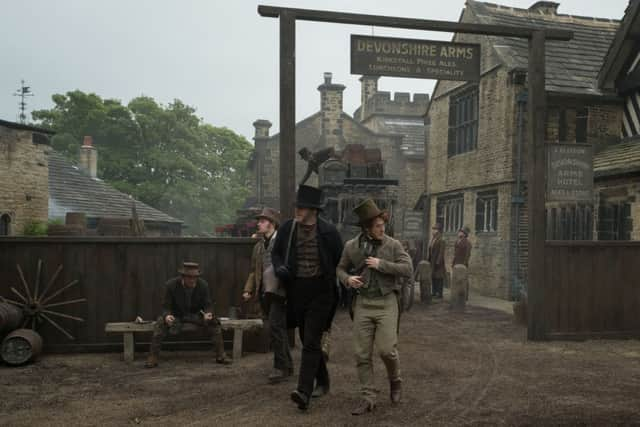Tragic yet immortal


Both Emily and Anne suffered from tuberculosis. Their brother Branwell had a multitude of problems, most of them self-inflicted. After their deaths came a brief respite for elder sister Charlotte, but by 1855 she was too was dead.
It might not be cheery stuff, but big things are expected from To Walk Invisible and Wainwright. She cut her directorial teeth with an episode of Happy Valley, which she also wrote, along with Scott and Bailey and Last Tango in Halifax and she was firmly at the helm of this story of “these three fascinating, talented, ingenious Yorkshire women”.
Advertisement
Hide AdAdvertisement
Hide AdWhat she has woven in is the relationship between the women and their laudanum-addicted brother and asks whether his envy of their successes drove him deeper into his pit of bleak despair? Branwell’s last outing before he stumbled home to the parsonage at Haworth, was to a local pub, where he became incoherent with drink, and where he couldn’t settle up his last bar bill.


It is an epic production and Wainwright confesses that she has been writing and refining a play on the Brontës for more than 10 years, and that she once wrote a screenplay on Emily for the BBC which became a BBC Radio 4 drama.
“After I’d made something of a mark with Happy Valley and the others, it was – perhaps – pretty easy to get off the ground. Which sounds smug, but it isn’t meant in that way. It hasn’t always been plain sailing. I remember when I first got on screen with At Home With The Braithwaites – and that was way back in 2000 – there were an awful lot of TV critics who didn’t like what I’d done. One b****** wrote, ‘There’s this woman Wainwright, who has been given a lot of prime-time television, at great expense, and she doesn’t know what to do with it’.”
The cast of To Walk Invisible is impressive. Emily, author of the complex classic Wuthering Heights is played by Chloe Pirrie, who was recently seen in the ratings-topping War and Peace. Finn Atkins, from Vera is the deeply ambitious Charlotte, whose experiences as a governess formed the background to Jane Eyre. And Charlie Murphy, who has worked with Wainwright before on Happy Valley, plays Anne, who wrote Agnes Grey and The Tenant of Wildfell Hall. The damaged Branwell, with his destructive behaviour, is Adam Nagaitis, another Happy Valley veteran, while Jonathan Pryce, direct from Game of Thrones and Wolf Hall, is their father Patrick.
Advertisement
Hide AdAdvertisement
Hide AdFilming took place during May and June this year, when the weather turned wet, and unpleasantly cold. And the filming wasn’t in a warm studio space, it was on location, high up on Penistone Hill, just outside Haworth itself, where no attention to detail was spared – to the point where a precise full-scale set of the parsonage was built over-looking an old quarry.


As Susan Newby, learning officer for the Brontë Parsonage Museum explains: “Sally Wainwright wanted it all to look exactly as it had done in the time that the Brontës lived here. And the building itself had extensions to it in later decades, and trees grew in the gardens that we still see today. They simply weren’t here in the 1840s. What viewers will see is as close to what it would have been like as it humanly possible.”
No-one has given a precise costing on the building of the Parsonage and all its contents, but it must run to the millions. Lucky for the BBC then that this is a co-production with other companies and investors, all of whom confidently expect huge viewing figures when it is sold around the world.
“Our visitors every year can be divided into about three distinct groups,” says Newby. “Yorkshire folk who want to drop by or re-visit, people from the rest of the UK who are visiting and want to see this iconic spot, and then our guests from every other corner of the world, all of whom are deeply devoted fans of the Brontë books. You name a country, and we’ve had visitors from it. Something about the lives of these three brilliant women seems to touch people at a very deep level.”
Advertisement
Hide AdAdvertisement
Hide AdIt was the first time Jonathan Pryce had worked with Wainwright, but it was an ambition fulfilled.
“I am such an admirer of her that if she was filming the phone book, and I was asked to read a few lines, I would want to do it for her,” he says. “When I got the script, I read it at one sitting, and – as you might expect – it was characteristically honest. Painfully so, at times.
“What did I know about the Brontë sisters? Very, very little. I knew and have read their work. I knew that their father was a clergyman, but I didn’t know he came from lowly farming stock in Ireland, but pulled himself up by his bootstraps to go to Cambridge.
“I didn’t know that he had run his own school for a while, or that, while he sent his daughters off to boarding schools, which they all hated, he self-tutored Branwell at home. Of course, I did quite a bit of my own research, but the writer should give you all the information that you need, and Sally certainly does that.
Advertisement
Hide AdAdvertisement
Hide Ad“I found it endlessly fascinating how the Rev. Brontë reacted – or failed to react – to his children. At one point, where he is virtually blind with cataracts, Charlotte says to him that she’d like him to read some of her stories. And he rather crossly says no – her handwriting is far too small.
“She replies that he’s got it wrong – these are the stories that she has had published. That they are in print. And he’s amazed. They never told him that they were sending their manuscripts off for consideration by publishers.
“And another key scene for me is an argument that goes on between Branwell and his father, where the young Brontë demands money from the older man, to pay for his drug habit and to settle his debts. It’s very threatening, very scary. There’s a lot going on behind closed doors in this piece, and that’s what made it so compelling for me. And as for the weather, well, when you have the real mists rolling in, and very real rain being blasted at you by gusts of wind, you get just a tiny inkling of what life must have been really like for them all.
“I have rather fallen for the man, though. He encouraged his girls to read and write from a very early age. I found that he wanted them to read people like Byron – which must have been very daring for the time. He was the first to recognise that they all had extraordinarily fertile imaginations. That they have touched so many hearts and minds over the decades…. now that is just mind-boggling.”
To Walk Invisible, BBC1, December 29, 9pm. For the best of the rest of this year’s highlights turn to our bumper film and television guide which begins on page 67.